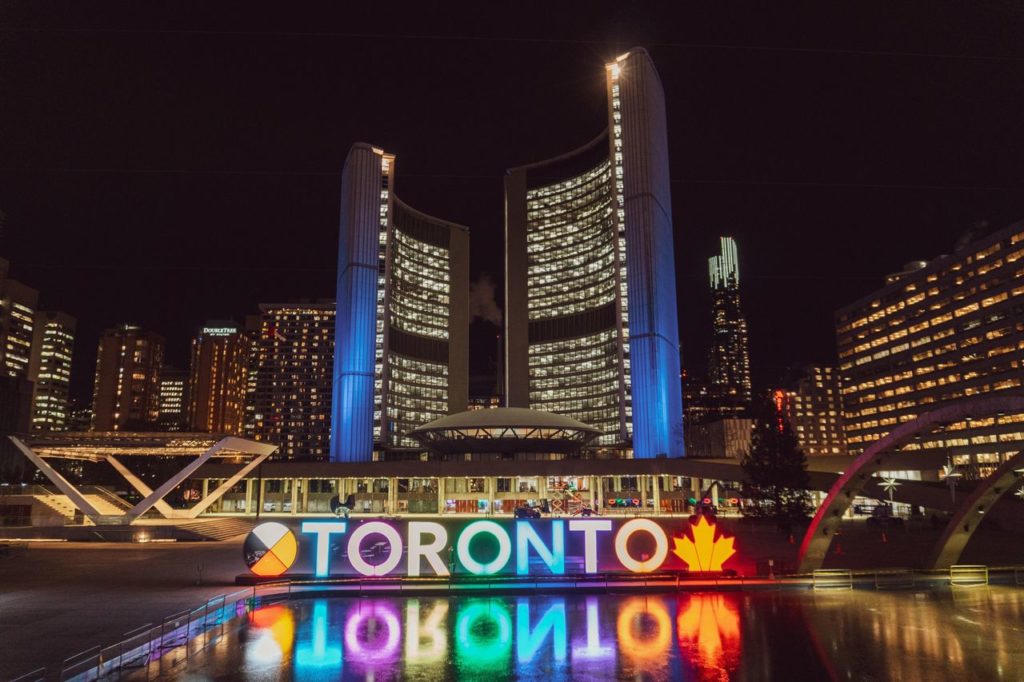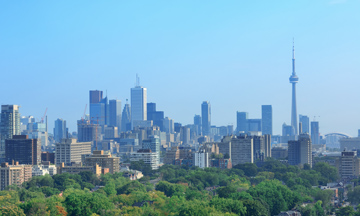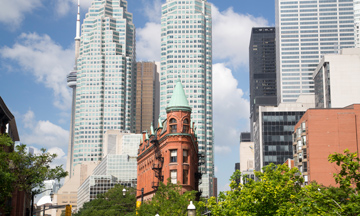
Toronto was already simmering before the advent of the pandemic, but the past two years have sent prices soaring amid feverish home buying in the Canadian city.
Prices across the greater Toronto area have risen by 22% in the past year, with the price of detached homes in the suburban areas of Toronto, known as the 905, experiencing 33% growth, according to data from the Toronto Regional Real Estate Board.
Still, potential buyers can hedge their bets against the possibility of a real estate bubble by looking to neighborhoods with less frenzied price growth, like the city’s downtown core, as well as its condominium and townhouse market.
“The prices in the surrounding areas of Toronto have been rising higher than the city,” said Cheryl Thompson, a real estate broker with Sotheby’s International Realty.
CLICK HERE TO LISTEN TO FULL INTERVIEW
Outline Financial, a boutique mortgage and insurance brokerage, has been keeping track of home price growth around the Golden Horseshoe.
“If you want to see any region that has benefited the most from Covid, it’s Durham,” said Outline’s Managing Partner Jason Lang, referring to the municipality that encompasses Toronto’s eastern suburbs.
Buyers have turned to the region’s larger properties to accommodate remote working, while supply has stayed limited, resulting in the average prices in Durham for detached homes growing 34.2% from October 2020 to October 2021, to C$1.1 million (US$860,000).
Similarly, in Simcoe County located just north of Toronto, prices for detached homes have increased 31% this year, to C$1.05 million.
While these regions might be leading the Golden Horseshoe’s growth, the rapid increases in home prices during Covid-19 are an anomaly. Over the past five years, detached-home prices have risen but at a considerably slower pace of around 8% each year, according to Outline’s data.
Exurban areas may be some of the first areas to feel shifts in the market. That was the case for Simcoe and Durham during the Canadian housing market’s last slowdown, in 2017. Now, as Toronto returns to pre-pandemic conditions, the exurbs might again be the first to see price growth slow, especially as workers are called back to the office and commuters start looking for homes closer to the city.
Look to Historically Strong Markets for Sure Capital Growth
Potential buyers could consider Toronto’s inner-city neighborhoods, where prices have risen less dramatically.
While all of Toronto’s inner-city markets experienced double-digit growth in the last year, some markets lagged behind, such as the area defined by district code C11—with 14.8% year-over-year average home price growth—and C09 with 14% growth. These neighborhoods, which comprise Rosedale-Moore Park and Leaside, saw slower growth, Ms. Thompson said, because prices were already so high that they had little room to grow.
While the condo market in the city center took a hit in 2020, signs show that may be reversing. Condo prices, which flatlined and then decreased earlier in the pandemic, have been slowly increasing this fall.
“Even the condo market has tightened up over the last half year,” said Jason Mercer, chief market analyst at the Toronto Regional Real Estate Board.
Renewed Foreign Investment May Signal Price Increases for Luxury Towers
In the first half of this year, sales of houses over C$4 million increased 250% year over year, Ms. Thompson said. In just the past month, Toronto has seen a 78% increase in houses selling for over C$4 million compared to a year ago.
Luxury high rises have continued to sprout up in the tony neighborhood Yorkville, like the 94-story One Bloor tower, where prices are averaging C$2,500 and C$3,000 a square foot, Ms. Thompson said—nearly three times more than the citywide average of about C$1,000 a square foot. Likewise, established neighborhoods like Forest Hill and Lawrence Park continue to be a sure bet, she added.
Areas along the soon-to-be-constructed Ontario subway line, which will run from Exhibition Place, through downtown, northeast toward the Ontario Science Center, have also continued to attract new development and will be ever more attractive to commuters, Mr. Mercer said.
As foreign investors gain confidence to re-enter the market, prices will only continue to climb.
“Toronto real estate is seen as a sure bet long term,” Ms. Thompson said. “We are the financial center for Canada. So on a world stage, our real estate is actually quite reasonable when you look at Manhattan, Hong Kong or London.”
Townhouses See More Stable Price Growth
Detached housing and condos tend to operate in their own cycles, Mr. Lang said. While there are periods in which they move together, they also often move in opposite directions, as they did during the pandemic. Wedged between those two fluctuating markets are the townhouse and semi-detached markets.
According to Outline data, townhouses and semi-detached houses in Toronto proper increased in price by 23.5% and 14%, respectively, from October 2020 to October 2021.
Townhouses often serve as a step between a buyer going from a condo to a detached home. But during the pandemic, many buyers who may have typically looked to upgrade decided to stay in their homes, or do renovations rather than move.
Now, as those buyers re-enter the market, the demand for these in-between property types could increase even further, Mr. Lang added.
Is There a Bubble?
Real estate brokers in Toronto often hear the same question: Is there a bubble?
In a recent study, UBS defined Toronto as one of the top three cities with the largest risk of a housing market bubble, among Hong Kong and Frankfurt. UBS’s definition of a bubble is less ominous than it sounds, however, referring only to the likelihood of deflating residential prices.
Between 2000 and 2017, real home prices in Toronto rose by more than 5% per year as the city’s population grew and international demand poured in. While the market cooled somewhat in 2017 as the country put in place new taxes on foreign buyers, as well as vacancy and rent controls, it shot right back up in 2020 with the pandemic.
But Toronto housing experts say that increasing population growth and limited supply means that momentum in the market won’t slow.
“The demand for housing—whether you’re talking about ownership or rental in the greater Toronto area—continues to increase on a year-over-year basis,” Mr. Mercer said.
As part of its Covid-19 recovery efforts, Canada’s government has increased its immigration targets to welcome over 400,000 people each year between 2021 and 2023—increasing the country’s population by 1% each year.
Toronto, Mr. Mercer continued, should expect to welcome the bulk of those new immigrants.
“People are moving in from all around the world to Canada and the GTA is Canada’s single-greatest metropolitan beneficiary of immigration,” he said. Meanwhile, the lack of housing supply will continue to push prices up.
“There’s no reason to believe that prices are going to go down,” Ms. Thompson said.


